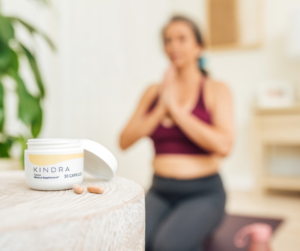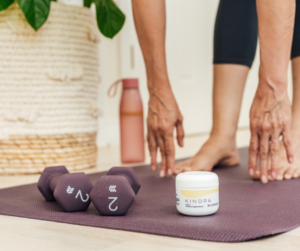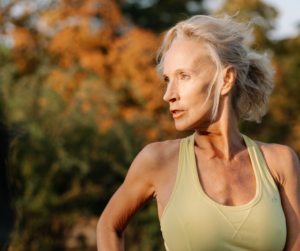Exercise at Midlife by Team Kindra
 Dr. Huian “Anan” Mathre, Kindra healthcare advisor and physical therapist discusses all things exercise and menopause.
Dr. Huian “Anan” Mathre, Kindra healthcare advisor and physical therapist discusses all things exercise and menopause.
There’s a natural tendency to view the body as weak and fragile as we get older. While there are unavoidable aspects to aging – at the end of the day, the human body is fundamentally strong and built for movement. Movement is medicine for the body.
Sometimes whether it’s due to a fear of injury, not enough time, or being overwhelmed with where to start, we stop moving. Menopause is an opportunity to embrace exercise and movement.
Before we dive in, note that you should always reach out to your doctor before starting a new exercise routine. They can provide you with individualized medical advice and help to guide you in what types of movement are the best fit for you.
Weight gain is common during midlife and menopause. Can exercise help?
Loss of estrogen can result in the redistribution of weight to the abdomen as well as decreased metabolism. Sarcopenia, the loss of muscle mass, is also more common as we age. Regular exercise burns more calories which can help offset these effects. Strength training, using body weight, handheld weights, or resistance bands, helps to build muscles. With more muscle mass, your body burns more calories and has a higher metabolism, even at rest.
Can exercise directly impact menopause concerns – hot flashes, libido, trouble sleeping etc?
Absolutely. Studies have shown that exercise can reduce some of the disruptive concerns of menopause. Pelvic floor strengthening can help alleviate some causes of painful sex. Aerobic activity can help with hot flashes and trouble sleeping at night. Regular exercise can decrease overall stress and cortisol levels. It can also increase body confidence and boost mood. While low energy related to menopause might make it difficult to increase your activity, regular exercise increases overall energy levels.
Vaginal atrophy, the thinning of the vaginal tissues as well as decreased lubrication is also caused by a reduction in estrogen. Aerobic exercise increases blood flow to the intimate area which helps to support those tissues. For extra comfort that is crucial during exercise and soothing relief, Kindra’s Daily Vaginal Lotion supports skin-moisture barrier healing, with 95% of women reporting meaningful improvement with as little as two uses.
 Bone density is a concern during menopause. How does exercise affect bone health? Are certain exercises better for targeting bone density?
Bone density is a concern during menopause. How does exercise affect bone health? Are certain exercises better for targeting bone density?
Loss of estrogen affects bone density and bone strength which can lead to osteoporosis and increases the risk of fractures. There are three main categories of exercises that help with bone health.
- Weight bearing, high impact exercises: Jogging, tennis, dancing, and jumping.
- Weight bearing low impact exercises: Walking and the elliptical machine.
- Strength training: Lifting weights, using resistance bands, weight machines, and body weight exercises like squats.
Talk to your doctor before starting a new exercise program to understand your bone density levels. Those that have low bone density should avoid certain exercise positions and the high impact exercises. All of the three above categories are excellent for building healthy bones. Bone tissue is built when muscles are challenged and contract, which exerts pressure on the areas where the muscle attaches to the bone. This pressure causes the body to produce additional bone tissue and increase bone density.
There are some exercises like cycling, swimming and stretches which have other excellent health benefits but do not stimulate bone density growth.
Are there other benefits to exercise specifically related to midlife and menopause?
As we get older, balance can get worse for a multitude of reasons. One of the biggest ways to work on this is improving overall strength. Incorporating Tai Chi or yoga positions can also challenge and improve balance directly.
Decreased estrogen levels in menopause can lead to hypertension as well as increase risk of heart disease. Aerobic exercise like swimming, dance class, bike ride, walking, jogging etc can significantly lower the risk of cardiac issues.
Exercise can help dramatically improve sleep quality – both allowing you to fall asleep faster and stay asleep longer. It’s particularly important to get restful sleep in between workouts as this is the time your body recovers. For additional sleep support, try Kindra’s non-habit forming Sleep Enhancing Supplement that is formulated with natural ingredients selected to keep night sweats at bay and allow for quality sleep with no grogginess the next morning!
What kind of exercises should be included in a routine and how often should someone be exercising?
The ideal exercise program includes both aerobic exercise and strength training. The American Heart Association recommends at least 150 minutes of moderate intensity aerobic exercise a week for cardiovascular benefits. Moderate intensity exercise means that you should be able to talk, but not sing, and you should not be breathless. 150 minutes a week equates to 30 minutes a day, 5 days a week. If this seems overwhelming, build up to this goal gradually.
It’s important to also supplement resistance exercises for bone health, increased muscle mass, and increased metabolism. Resistance bands, weight machines, and body weight exercises are all excellent options. Aim for 3 sets of 12 repetitions per exercise.
 It is pretty well documented that there are powerful benefits to exercise but what are some ways to stay motivated?
It is pretty well documented that there are powerful benefits to exercise but what are some ways to stay motivated?
The best exercise is the one you’ll stick with because you enjoy it. If you detest walking on the treadmill, then that’s not the aerobic activity you should plan on including in your routine. The key is to find what works for you. Some people enjoy group workouts because of accountability and community whereas others like to lean into solo time.
It may be helpful to try a supplement like Kindra’s Focus Supplement just before you exercise. This game-changing capsule increases your body’s production of ATP, a crucial molecule for energy production that helps improve focus and stamina, too.
Try making small changes in your routine to build up to your goal. This process takes time. The goal is not to seek perfection but create sustainable lifestyle change. You got this.
Parting words from Kindra
Kindra is on a mission to help you prepare for, manage, and embrace your body’s natural hormonal shifts with our line of estrogen-free essentials. Everything we do is by women, science-backed, safe and estrogen-free and community driven. If you’re feeling called to learn more about what Kindra products are right for you, take our quiz. Interested in learning more about our brand? We’d love to chat! Reach us at [email protected]. We look forward to joining you during your better half.
Kindra has an exclusive offer for the Motherhood Later community. Use LATER for 15% off your first order or subscription.
Tags: aging well, cardio, exercse, hormones, Kindra, menopause, self-care, yoga















